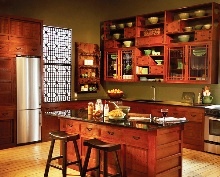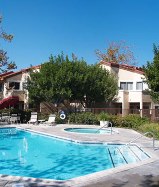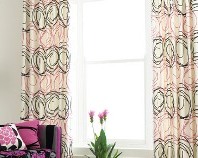Classic Decorating Is All About Tablescapes
 July 28, 2011
July 28, 2011 
(David Hicks tablescape)
David Hicks, British superstar interior designer, coined the phrase “tablescapes” back in the 1960s. Tablescapes are creatively composed accessories set on a table, each piece specially chosen until the whole is greater than the sum of its parts.
Hicks has long since died, but his design flair and attention to detail still inspires designers of today. The attention to detail led Hicks to compose miniature design scenes on tables so meticulous that his tablescapes became mirrors of his overall design concept. The classic tablescape shown in the photo above alludes to the Greek classical décor behind the table. The simple but elegant ceramics and earthenware – a staple of Greek interiors – is a beautiful way to complement the surrounding room.
When arranging a tablescape, the guidelines that designers pay attention to are
- the focal point,
- the various heights,
- scale,
- the number of items on the table,
- how the accessories harmonize with the other items, and
- the overall color scheme.
 (Rod Winterrowd - Hallway)
(Rod Winterrowd - Hallway)
The tablescape on the left by Rod Winterrowd is located in a very narrow hallway that might have easily been overlooked by a homeowner when decorating his or her home. Winterrowd highlights the small space by providing visual interest at varying levels as well as an exotic and architectural theme. The sphinx at the base of the table and the Chinese lantern reflects the exoticness, the curving staircase and the architectural line drawings provide the architectural theme.
Despite the varied accessories, the overall effect is well balanced and harmonious. Another guideline to tablescapes is to use an odd amount of accessories, e.g., using 3, 5, 7, or 9 grouped items. Winterrowd uses 5 accessories with balancing heights to achieve a harmonious effect. He also creates a vertical axis from the lantern above to the flower arrangement and the sphinx below, resulting in a focus point.
 (Sherrill Canet - Front Room)Designer Sherrill Canet uses the guideline of varying heights to great effect for her tablescape (see above). The viewer’s eye travels up and down from the bowl to the candlestick holders, to the design books, and back up to a glass conical sculpture and down again to the glass spheres. The overall colors are limited to mostly white and glass so as not to distract from the colorful glass plates and the striking striped pattern in the background made from Blue Suede Shoes paint by Benjamin Moore. The only splash of color on the table is the Pucci design book that picks up the bright blue color scheme.
(Sherrill Canet - Front Room)Designer Sherrill Canet uses the guideline of varying heights to great effect for her tablescape (see above). The viewer’s eye travels up and down from the bowl to the candlestick holders, to the design books, and back up to a glass conical sculpture and down again to the glass spheres. The overall colors are limited to mostly white and glass so as not to distract from the colorful glass plates and the striking striped pattern in the background made from Blue Suede Shoes paint by Benjamin Moore. The only splash of color on the table is the Pucci design book that picks up the bright blue color scheme.
 (Wayne Nathan - Hall)Sometimes the overall tablescape becomes the focal point for the whole room as in the case of Wayne Nathan’s arrangement on the left. Here, the pink lacquered table and its accessories provide a focal point for the hallway and the stairwell, both on the first floor and on the stairs looking down. The choice of the hot pink color makes it a natural focal point in the pale blue room. Nathan uses tall and short bouquets of cherry blossoms and roses to provide varying heights. The branches of the cherry blossoms carry the viewer’s eye from the bottom of the stairs upwards to the upper floor.
(Wayne Nathan - Hall)Sometimes the overall tablescape becomes the focal point for the whole room as in the case of Wayne Nathan’s arrangement on the left. Here, the pink lacquered table and its accessories provide a focal point for the hallway and the stairwell, both on the first floor and on the stairs looking down. The choice of the hot pink color makes it a natural focal point in the pale blue room. Nathan uses tall and short bouquets of cherry blossoms and roses to provide varying heights. The branches of the cherry blossoms carry the viewer’s eye from the bottom of the stairs upwards to the upper floor.
 (Wayne Nathan - Stairwell)Tablescapes are also a modest way to express your design concepts – they're easy on the budget. The next time you want to give new life to a room, consider creating your own tablescape and personalizing it with your own or your clients' treasured mementos.
(Wayne Nathan - Stairwell)Tablescapes are also a modest way to express your design concepts – they're easy on the budget. The next time you want to give new life to a room, consider creating your own tablescape and personalizing it with your own or your clients' treasured mementos.
 This article was reprinted by permission of the Sheffield School. Are you interested in learning more about decorating with accessories? Take a look at Sheffield School's Complete Course in Interior Design. At Sheffield, you will learn how to transform a space, create color schemes, and select furniture, lighting, and accessories.
This article was reprinted by permission of the Sheffield School. Are you interested in learning more about decorating with accessories? Take a look at Sheffield School's Complete Course in Interior Design. At Sheffield, you will learn how to transform a space, create color schemes, and select furniture, lighting, and accessories.
 David Hicks,
David Hicks,  accessories,
accessories,  tablescapes,
tablescapes,  tips in
tips in  interior design
interior design 












Reader Comments (1)
Wonderful post about tablescapes. These guidelines sound quite useful. Good post.